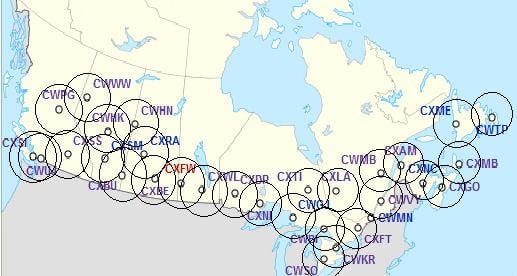 | ||
The Canadian weather radar network consists of 31 weather radars spanning Canada's most populated regions. Their primary purpose is the early detection of precipitation, its motion and the threat it poses to life and property. Each has a range of 256 km (159 mi) in radius around the site to detect reflectivity, and a range of 128 km (80 mi) for detecting velocity patterns (Doppler effect).
Contents
History
Research in weather radars in Canada began at the end of the Second World War with "Project Stormy Weather". After the war, J.S. Marshall continued at McGill University the work with the "Stormy Weather Group". The Canadian network was thus gradually formed and by 1997, there were 19 weather radars of two kinds across the country: 18 five centimeter wavelength (C-Band) radars and 1 ten centimeter wavelength (S-Band) at McGill, all of the radars detected reflectivity with 3 sites equipped with Doppler capabilities (Carvel, King City and McGill).
Environment Canada received approval in 1998 to upgrade the network to Doppler standard and to add 12 more radars with the operational characteristics coming from King City weather radar station (CWKR), the research radar of Environment Canada. However, McGill radar (at the J. S. Marshall Radar Observatory), while being part of the network, is owned by McGill University. It is a research as well as an operational radar and is modified independently. The Jimmy Lake and Lac Castor stations are owned and operated by the Department of Defense (DND), these are also part of the network.
Characteristics
Scanning strategy
Because the network is using C band radars, compromises had to be used (see Doppler dilemma) between maximum reflectivity range and maximum non ambiguous velocities. The actual scanning strategy (2006) is divided in two separate scans over 10 minutes:
The McGill radar is currently the only station that uses a S-band transmitter instead of a C-band transmitter to acquire reflectivities and velocities during each of its 24 elevation angles with the same 5 minute cycle time.
Modernization project
Environment Canada received the funding from the Treasury Board in 2011 to undergo a major modernization project called 'WES Renewal' to upgrade to dual polarization all Canadian Radars in two separate five year plans. Complete network stabilization and systemic problems resolution will also be part of this major effort by Environment Canada. The first five years will concentrate on the upgrade of the ten 98A radars to dual polarization. McGill will be upgraded to a new antenna (will either remain S-Band or change to C-Band), but will be operated by Environment Canada in the near future (probably by 2016).
List of radars
The first modernization process began in the fall of 1998 with the opening of Bethune radar and ended in 2004 with the one in Timmins.
